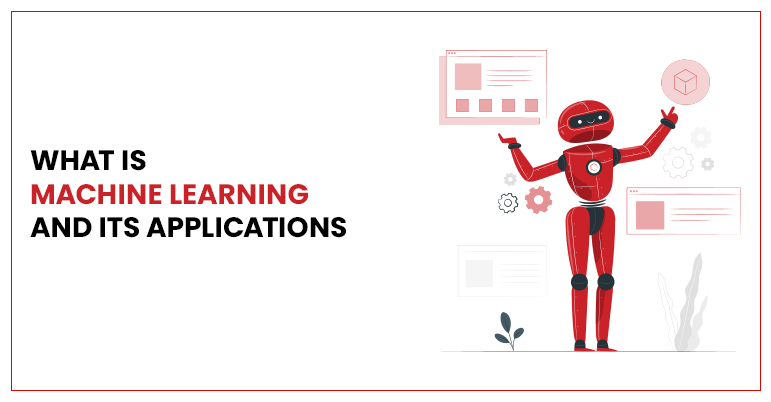What Is Machine Learning and Its Applications?
August 2, 2021
admin
Machine Learning (ML) has proven to be one of the decade’s most game-changing technological developments. In today’s increasingly competitive business world, machine learning allows businesses to accelerate their digital transformation and move into the age of automation. Machine learning algorithms’ ultimate adoption and pervasiveness in corporations are well-documented, with various companies using machine learning at scale across verticals. Some would even claim that AI/ML must be relevant in specific industries, such as digital payments, banking fraud detection, and product suggestions.
Machine learning is now used in some form or another in almost every other tool and software on the Internet. Machine Learning has become so prevalent that it is now the go-to method for businesses to handle a wide range of issues. We’ll go through what machine learning is, the principles of ML, several types of machine learning algorithms, and a few examples of machine learning in action in this article.
WHAT IS MACHINE LEARNING?
AI was able to progress beyond only doing the tasks it was designed to do, thanks to machine learning algorithms. AI systems were only employed to automate low-level operations in corporate and enterprise settings until ML became ubiquitous. Intelligent automation and primary rule-based classification were among the tasks included. This meant that AI algorithms were limited to the domain in which they were being used. On the other hand, machine learning allowed computers to go beyond doing what they were taught to do and begin growing with each iteration.
Machine learning is fundamentally different from artificial intelligence in that it can evolve. Machine learning algorithms can process vast volumes of data and extract meaningful information using various programming techniques. In this approach, they can learn from the data they’re given and improve on earlier versions.
Big data, one of the most significant components of machine learning algorithms, cannot be discussed without mentioning machine learning. Because AI mainly relies on statistical approaches, any sort of AI is usually reliant on the quality of its dataset for successful results.
A good flow of organized, varied data is essential for a robust ML solution, and machine learning is no exception. Companies have access to a tremendous amount of data about their clients in today’s online-first world, typically in the millions. The sheer volume of information in this data, which is vast in the number of data points and the number of fields, is referred to as big data.
Big data is time-consuming and challenging to process by human standards, yet good data is the finest feed for training a machine learning algorithm. The more effective the machine learning algorithm’s training will be in a large dataset, the cleaner, useable, and machine-readable data. Machine learning algorithms, as previously stated, can improve themselves through movement. Today, three common strategies are used to train machine learning algorithms. Machine learning can be divided into three categories: supervised learning, unsupervised learning, and reinforcement learning.
TYPES OF MACHINE LEARNING
● SUPERVISED LEARNING
One of the most basic types of machine learning is supervised learning. The machine learning algorithm is trained on labeled data in this case. Even though precise labeling of data is required for this method to work, supervised learning can be incredibly effective when utilized under the right situations. The ML algorithm is given a short training dataset to work within supervised learning. This training dataset is a subset of the larger dataset. It provides the algorithm with a rudimentary understanding of the problem, solution, and data points to be handled. In terms of characteristics, the training dataset is quite similar to the final dataset, and it gives the algorithm with the labeled parameters it needs to solve the problem.
The program then establishes a cause-and-effect relationship between the variables in the dataset by finding connections between the parameters given. By the end of the training, the algorithm understands how the data works and how the input and output are related. The final dataset is then used to train this solution, which it learns from in the same way as the training dataset. This means that supervised machine learning algorithms will improve even after being deployed, identifying new patterns and relationships as it learns new data.
● UNSUPERVISED LEARNING
The ability to deal with unlabeled data is a benefit of unsupervised machine learning. The program perceives relationships between data points in an abstract fashion, with no human input required. This means that no human labor is necessary to make the dataset machine-readable, allowing the program to work on much larger datasets. The labels in supervised learning will enable the algorithm to determine the exact nature of any link between two data points. On the other hand, unsupervised learning lacks titles to deal with, leading to hidden structures. Unsupervised learning algorithms’ versatility is due to the formation of these hidden structures. Unsupervised learning algorithms can adapt to the data by dynamically modifying hidden systems instead of a predetermined and fixed problem statement. Compared to supervised learning techniques, this allows for more post-deployment development.
REINFORCEMENT LEARNING
Reinforcement learning is directly inspired by how people learn from data in their daily lives. It includes a trial-and-error algorithm that improves upon itself and learns from different scenarios. Positive outcomes are rewarded or ‘reinforced,’ while adverse effects are discouraged or ‘punished. Reinforcement learning works by placing the algorithm in a work environment with an interpreter and a reward system, based on the psychology idea of conditioning. The output result of each iteration of the algorithm is delivered to the interpreter, who decides whether the outcome is beneficial or not.
If the program finds the proper solution, the interpreter reinforces it by rewarding the algorithm. If the result is unfavorable, the algorithm is obliged to repeat the process until a better result is found. In the vast majority of circumstances, the reward system is directly proportional to the effectiveness of the outcome.
APPLICATION OF MACHINE LEARNING
One of the primary selling reasons for adopting adaptive machine learning solutions by firms and organizations across verticals is their dynamic nature. Machine learning algorithms and solutions are adaptable and, under the right circumstances, can be utilized to replace medium-skilled human work. In situations where the solution must continue to improve after deployment, machine learning methods are applied.
- Customer service representatives at large B2C companies, for example, have been replaced with chatbots, which are natural language processing machine learning algorithms. These chatbots may evaluate consumer queries and provide assistance to human customer service representatives or deal directly with customers.
- Machine learning algorithms can also aid online platforms in improving user experience and customization. To avoid content saturation and give unique content to individual users based on their likes and dislikes, Facebook, Netflix, Google, and Amazon all use recommendation algorithms.
- Facebook uses recommendation engines to locate relevant leads for its news feeds on Facebook and Instagram and its advertising services. Netflix collects user data and makes recommendations for movies and series based on the user’s tastes. Google uses machine learning to structure its results and for YouTube’s recommendation system, among other things. Amazon employs machine learning to display relevant products in the customer’s field of view, increasing conversion rates by recommending items that the user wants to buy.
However, as machine learning (ML) is increasingly used in various industries and applications, it’s becoming more necessary to understand the differences between artificial intelligence and machine learning.
ENDNOTE
Anyone working in the computer industry today should have a fundamental understanding of machine learning and artificial intelligence. Working knowledge of AI is necessary to stay relevant in today’s tech environment because of its pervasiveness. This makes AI a fascinating job option for people who have the required skills and expertise. Because this area combines statistics, computer science, custom software development services, and logical reasoning, it has a wide range of opportunities for newcomers. Furthermore, hopefuls can choose from several roles such as data scientists, machine learning engineers, and AI developers.





